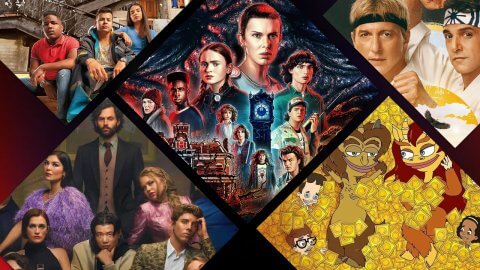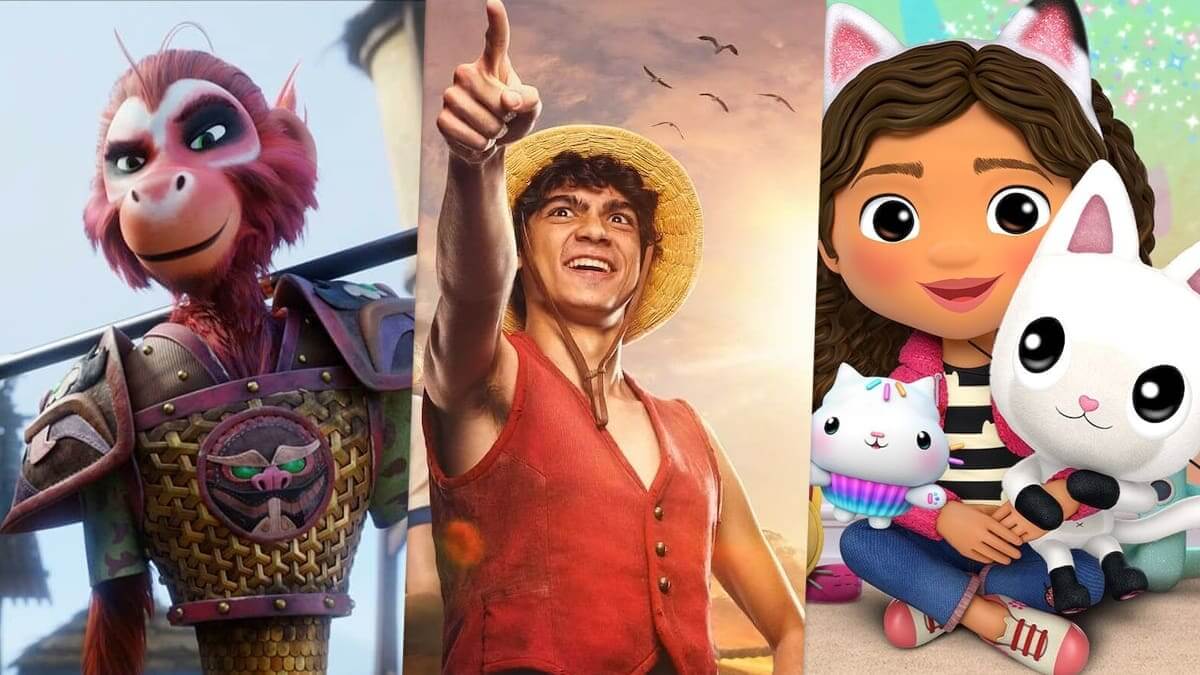
Pictured: The Monkey King, One Piece and Gabby’s Dollhouse
Netflix earnings just hit, and we’re here to look over the key takeaways from the month and look at how well Netflix’s kids’ slate has been performing over the past quarter.
A quick note before we dive in: The thumping gazumping of the Apple-Skydance Animation deal needed an entire article for unpacking. As a quick recap, around 20 minutes before earnings hit, news broke that Skydance Animation, under John Lasseter, was unceremoniously dropping its previously agreed and in-process Apple TV+ deal in favor of a partnership with Netflix.
There are lots of reasons why this is interesting for the industry at large, but keeping it to Netflix for a second, CEO Ted Sarandos cited the ongoing footprint of animated movies in US Nielsen rankings as a core justification for this deal. Netflix is supposedly happy with its original animated feature output so far; performance vs. theatrically released movies be dammed. This was positioned as a pipeline diversification to help make up for the development timeline.
Other key headlines for Netflix Q3 2023:
- Subscribers were up, up, up – particularly year on year, definitely helped by the successful crackdown on password sharing. And by successful, I mean they cracked down, but they also managed to convert many of these users to paying sharers or out-and-out subscribers. Incidentally, subscription prices are also up in the UK, US, and France.
- Ad sales are still crawling… There were executive moves. It would not be “material to the Netflix business in 2023” but still represents a long-term opportunity, with ad tier driving around 30% of signups in markets where it’s available.
- International markets and content were a core part of the story… Over 70% of Netflix subscribers are now outside the US. Local programming remains a key part of the content strategy. The live-action manga adaptation, One Piece, saw #1 ranking in more countries in the world than Wednesday or Stranger Things. Further details on that below.
More on the Top 10 Hours Viewed Metrics Change
Sarandos talked about the movement towards transparency in streaming as a result of the strikes and beyond. He said that the industry at large was:
“heading toward a world where streaming data will be much more readily available…it’ll be much more common for the data to be fully transparent.”
As announced ahead of the last Netflix earnings, the company changed how they would report their weekly Global Hours Viewed ranking. This, going forward, would now be based on “views” rather than “hours viewed”. “Views” basically accounts for the total of “hours viewed” divided by the duration of the content rather than revealing any actual additional data.
Some folks are fans of this approach; it somewhat levels the playing field regarding content with shorter durations. Sitcoms, comedy specials, and actually kids shows (more on that below) have seen greater visibility in the ranking than before. Strictly speaking, the metric is not something I love for kids content for a few reasons. It sits awkwardly with the way kids rewatch for one. Also, if you give us “views,” tell us the actual views in a metric closer to old-school reach.
My griping is not enough to shake the industry, unfortunately, as it seems this “views” metric is being picked up, at scale, as the streaming standard. Since it was settled at Netflix, Disney has used the same approach to make the first public data announcements about Disney+ content performance for Elemental, The Little Mermaid, and Ahsoka. Moreover, “views” is the metric referenced as part of the Writer’s Guild agreements, so I guess it’s here to stay.
Netflix Kids Content Performance for Q3 2023
Kids Series
So, now that I’m done with griping …. YAYYYY – this metric definitely means that more kids’ series float to the top!!
Gabby’s Dollhouse Season 8 wins the quarter. The season featured in the Netflix Global Hours Viewed Top 10 for four consecutive weeks. Go DreamWorks! Global Hours looks at performance on a season level, so we can only see what numbers Season 8 itself drove, rather than the halo viewing that undoubtedly spilt out to other episodes in the series. This is frustrating because it doesn’t really capture the whole picture… oh wait, I’m back griping again; sorry about that.
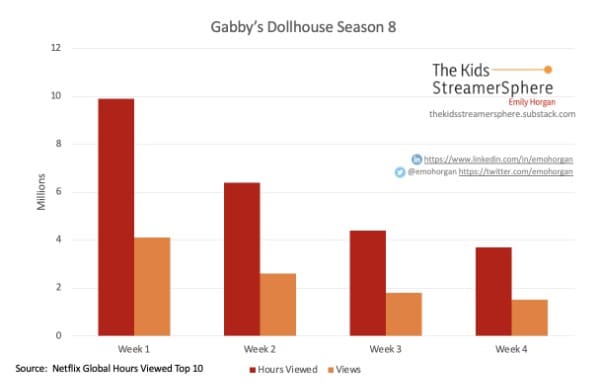
Graph for Gabby’s Dollhouse season 8 viewership
This is the first kids’ series we’ve seen having a run this long. I find this exciting, as Netflix typically shares 28-day metrics with partners, so this is the closest we have as a benchmark. 24.4 million hours viewed and 10 million views.
Another younger-skewing show, Om Nom Stories, also enjoyed a slot in the ranking for three whole weeks. This languageless, compilated short form series is derived from Cut the Rope, the viral game hit from 2010. Remember those days? It was all Candy Crush and Farmville rather than TikTok and Roblox. At just 60 minutes of content, this was definitely elevated by the new duration-to-views ratio. Actual hours viewed were on the low side, an average of around 2 million per week. This pales compared to Moonbug’s Little Angel, which had ten million+ hours. Using the new views metric, things come far more in line.
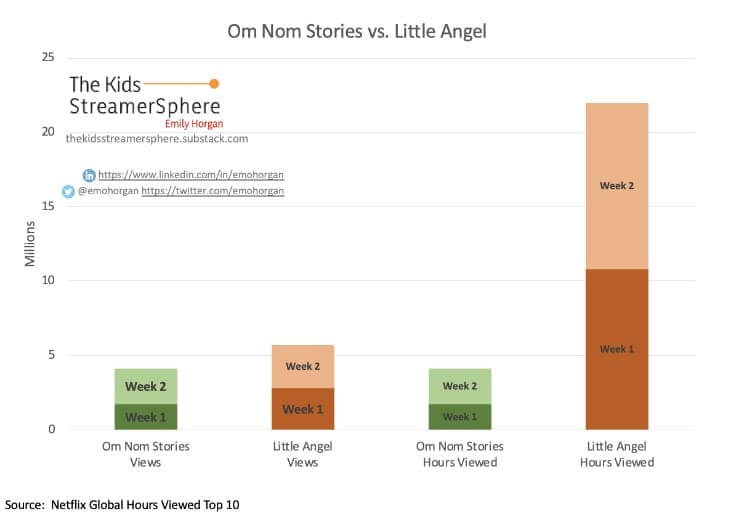
It’s not inconsequential that Netflix launched a bespoke “daily” version of the original Cut the Rope game in parallel with the series, into their games platform. This isn’t the first time they’ve dabbled with coordinated multiplatform content drops. Sonic Prime Season 2 also launched concurrently with the Sonic Prime Dash game. If you’re interested, there’s a full tracker of Netflix games here.
For older kids, another relative success story is Mech Cadets. The series popped through for one week with 7.3M hours viewed. We’re delighted you’re here, Mech Cadets, but this is below what we’ve seen is possible for other shows in this demo, like Oddballs or The Cuphead Show! which both saw 11 million+ hours viewed in their first weeks.
Finally, on the live-action series front, Netflix continues to show they know how it’s done for teens. One Piece, a swashbuckling pirate romp adapted from the manga series, had a rollicking performance. It was held up multiple times in earnings as
“a great example of Netflix’s variety, reach, recommendations and fandom at play.”
Kids Films
On kid’s movies, the disappointing streak for Netflix’s original animated features continues and now sits in a totally different context in light of the Skydance Animation deal. The Monkey King, released at the end of July, was better than The Magician’s Elephant but nowhere near The Sea Beast.
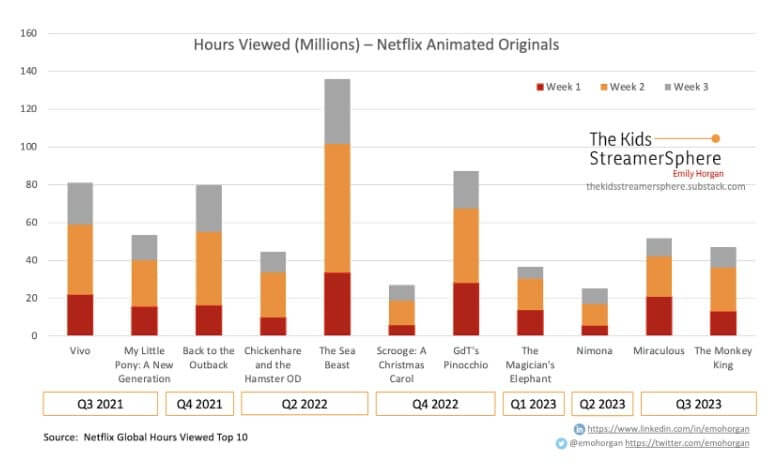
Hit franchise Miraculous Ladybug also had its feature streaming debut. It drove good numbers, despite excluding its home market of France, where it was released in cinemas and even held its own against Barbie.
Legacy theatrical animated films continued to pop, despite the fact distribution is fragmented by country. Viewership for the Pay 1 window of Puss in Boots: The Last Wish in the US and South Korea was enough to push it to impact globally.
On the live-action front, Spy Kids: Armageddon interestingly also comes for the Skydance Media partnership at large. Hopes might have been high for this. Sky Kids creator Robert Rodriguez had a sleeper hit with a similar kids-save-the-world movie on Netflix in Christmas 2020. Based on the new “views” metric, We Can Be Heroes became a Top 10 hit of all time, pulling in 137.3 million views in 90 days. Spy Kids: Armageddon had 32.8 million views across its first three weeks. Given this initial launch period tends to be when most of the engagement is brought in, I would doubt that it will match the run of its predecessor.
What’s Next for Netflix Kids?
Perhaps Netflix is all in on its animated feature correction. Great hopes were voiced at earnings for both Leo, starring Adam Sandler (“hysterical” according to Ted), and Chicken Run: Dawn of the Nugget from Aardman (which got thumbs up from site editor Kasey Moore).
Upcoming US premieres of Spider-Man Across the Spider-Verse (Oct 31st) and The Super Mario Bros. Movie (likely in the run-up to Christmas) should also deliver on the numbers.
On the series front, CoComelon Lane has set a debut date of November 17th. Derived from the hit Nursery Rhyme YouTube series, this will test whether Moonbug Entertainment can truly iterate and elevate what some would criticize as content brain candy.
It was also recently announced that the company is looking to open brick-and-mortar retail locations under the banner of Netflix House. Such touchpoints for brand extension have to be welcome if Netflix truly wishes to succeed with kids IP.
John Lasseter at Skydance Animation entirely comes from the background of working within the Disney-Pixar franchise/marketing “machine.” We’ve seen the absence of this machine unhinge success for another former Disney creative, Chris Nee.
He’s also used to films that can coast on a theatrical splash. The data says that a cinema release is only additive to performance in streaming. Perhaps this will be the deal that will finally unlock Ted Sarandos’ theatrical window trigger.



